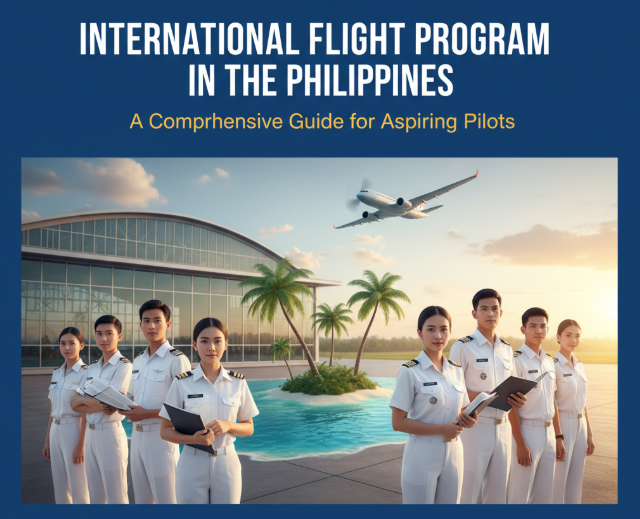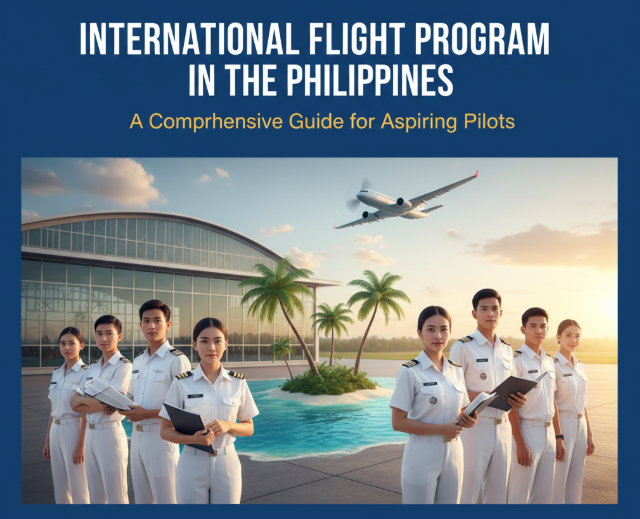
Introduction to International Flight Program in Philippines
The Philippines has become an important hub for aviation education, offering aspiring pilots the opportunity to train for both domestic and international flight programs. The International Flight Program in Philippines is designed to meet the increasing demand for skilled pilots in global aviation markets. As the aviation industry continues to grow, both locally and internationally, the Philippines is increasingly recognized as an ideal destination for pilot training due to its competitive tuition rates, well-established institutions, and access to diverse flying conditions.
Aviation in the Philippines is more than just an industry; it is a growing sector that plays a crucial role in both national defense and civil aviation. By enrolling in an international flight program, students are not only equipped with the skills needed to operate aircraft but also prepare for the challenges and responsibilities of aviation careers worldwide.
What is an International Flight Program?
An International Flight Program refers to a structured curriculum that is internationally recognized, focusing on aviation theory, flight training, and practical experience necessary for becoming a licensed pilot. This program offers students the ability to learn the nuances of flying within the context of global aviation standards. Students from all over the world travel to the Philippines to undergo this training, which prepares them for licensing exams, careers as airline pilots, and advanced flight roles.
Importance of Aviation in Philippines
The Philippines, being an archipelago with more than 7,000 islands, has a robust aviation sector that is integral to its economic and social development. Aviation in the Philippines plays a central role in both commercial and private sectors, enabling smooth transportation, fostering tourism, and contributing significantly to the country’s GDP. Furthermore, the strategic location of the Philippines within Southeast Asia makes it a pivotal hub for regional and international flights.
Key Importance Points:
- Boosts Economy: The aviation sector supports local businesses and tourism, creating jobs and opportunities for economic growth.
- Connectivity: Aviation ensures better connectivity, both domestically and internationally, for trade, commerce, and travel.
- Defensive Role: The Philippines also uses aviation programs to enhance national security through military aviation and space exploration programs.
History and Development of Aviation in Philippines
Early Aviation History of the Country
The history of aviation in the Philippines dates back to the early 1900s, with the first recorded flight in 1911. The first flight was conducted by a Filipino-American, Carlos P. Romulo, who became a pioneer in the country’s aviation industry. The establishment of the Philippine Air Lines (PAL) in 1941 marked the beginning of modern aviation in the country, followed by the growth of other airlines and the expansion of airports across the nation.
Milestones in Philippine Aviation
- 1941: Philippine Airlines (PAL) is founded as the first airline in Asia.
- 1950s-70s: The rise of commercial aviation, connecting the Philippines with the rest of the world.
- 1990s: Expansion of domestic routes and international connectivity.
- 2000s-present: Increasing focus on pilot training and certification programs to meet global demand.
Current Role of International Flight Program in Philippines
Today, the International Flight Program in the Philippines is a recognized path to becoming an airline pilot. These programs are not only popular among Filipinos but also attract students from all over the world, especially from neighboring Southeast Asian countries and even Europe. The government, along with private institutions, is actively investing in aviation infrastructure to keep up with the global demand for pilots.
These flight programs, which include training in flight schools, aviation institutes, and pilot academies, provide the necessary education and experience to meet international aviation standards.
Eligibility, Training, and Skills Required
Basic Qualifications
To enroll in an international flight program in the Philippines, candidates must meet certain educational and health requirements:
- Age: Typically between 17 and 30 years old.
- Education: A high school diploma with a focus on subjects like mathematics and physics is often required. Some programs may require a bachelor’s degree.
- Medical Standards: Applicants must pass a Class 1 medical exam to ensure they are physically fit for flying.
Technical and Soft Skills Required
- Navigation and Meteorology: A solid understanding of flight navigation systems and weather forecasting is essential.
- Leadership: Pilots must be able to make quick decisions, often under stressful conditions, and manage a team of co-pilots and cabin crew.
- Problem-Solving: Pilots need to solve technical problems while in-flight, ensuring the safety of passengers and crew.
Institutes, Academies, and Training Centers in Philippines
Leading Aviation Institutions
There are numerous institutions in the Philippines that offer internationally recognized flight programs. Some of the leading aviation schools include:
- Philippine State College of Aeronautics: A government-run institution that offers a comprehensive aviation program with a focus on both civil and military aviation.
- AeroFlight Aviation School: Known for its state-of-the-art flight simulators and advanced pilot training.
- Philippine Air Force Aviation School: Offers programs specifically geared towards training pilots for military aviation roles.
- Royal Air Aviation School: Focuses on training commercial pilots with a strong foundation in international flight standards.
- PAL Aviation School: A well-known institution that offers training directly aligned with the needs of Philippine Airlines, one of the country’s largest carriers.
Government Initiatives
The Philippine government has also recognized the importance of aviation in driving the economy and ensuring national security. Through various programs, such as the Civil Aviation Authority of the Philippines (CAAP) and partnerships with global agencies, the government has been enhancing aviation infrastructure and training capabilities.
Technology and Innovation in Aviation Training
In the modern era, technology plays a vital role in aviation training. The Philippines is home to several institutions that use cutting-edge technology to provide an enhanced learning experience for their students.
Flight Simulators and AI in Training
- Flight Simulators: These allow students to practice flying without leaving the ground, enabling them to simulate real-world scenarios.
- AI in Cockpit Training: Some institutions are integrating AI into their curriculum to prepare pilots for the future of flying, such as fully automated cockpits.
- Spacecraft Navigation: While still in its infancy, space exploration training is beginning to make its way into aviation programs, particularly in collaboration with space agencies like NASA and ISRO.
Global Agencies and Their Role
The Philippines benefits from collaborations with global aviation agencies like NASA, ISRO, and ESA, bringing innovation and advanced technology into local flight programs. These partnerships provide students with insights into future trends such as space tourism, private aviation, and AI-powered flight systems.
Challenges Faced in Pilot Training in Philippines
While the international flight program in the Philippines offers excellent training, there are several challenges that aspiring pilots may face during their training journey.
Infrastructure Gaps
Despite progress, some schools face challenges in upgrading their infrastructure to keep up with international standards, particularly in remote areas.
High Costs
Flight training can be expensive, with fees for flight hours, ground school, and additional certifications adding up. This may limit access for some students.
Regulatory Hurdles
Regulations regarding licensing and certification can be complex, and navigating these requirements may prove challenging for foreign students.
Brain Drain
Many Filipino-trained pilots leave the country for better job opportunities abroad, which affects the local aviation sector’s ability to meet domestic needs.
Future of International Flight Program in Philippines
The future of aviation in the Philippines looks promising, with the increasing integration of space tourism, AI in aviation, and private aviation. In the coming years, we can expect more investments in pilot training programs, modernized training equipment, and partnerships with international space agencies.
National Projects and International Collaboration
The Philippines may collaborate with international projects like India’s Gaganyaan and China’s CNSA lunar programs to contribute to space exploration, and in turn, bring advanced training opportunities for its aviation students.
Career Path & Opportunities
Step-by-Step Process
- Education: Complete high school or a bachelor’s degree.
- Pilot License: Enroll in a flight school and obtain your Private Pilot License (PPL).
- Advanced Training: Further training leads to the Commercial Pilot License (CPL), then to Airline Transport Pilot License (ATPL).
- Join an Airline: With an ATPL, pilots can work for airlines, military, or even space programs.
Salary Expectations and Global Scope
In the Philippines, a starting airline pilot can earn anywhere from ₱40,000 to ₱100,000 per month, with senior pilots making much more. Internationally, experienced pilots can earn significantly higher salaries, with international airline pilots averaging USD 100,000 to 200,000 annually.
FAQs
- How much does pilot training cost in the Philippines?
Training costs typically range from ₱1.5 million to ₱3 million depending on the program. - Which is the best aviation institute in the Philippines?
The best institute depends on your specific needs, but Philippine Air Force Aviation School and PAL Aviation School are among the top choices. - What qualifications are needed for pilot training in the Philippines?
A high school diploma, good physical health, and the ability to meet medical and age requirements are necessary. - Is international flight training available in the Philippines?
Yes, many schools in the Philippines offer internationally recognized flight training programs. - What is the future of aviation in the Philippines?
The future looks bright, with growing investments in space tourism, AI in aviation, and global airline expansion.
Conclusion / Final Thoughts
As aviation continues to evolve in the Philippines, aspiring pilots have a world of opportunities ahead of them. The International Flight Program in Philippines offers a gateway to a successful and fulfilling career in aviation, whether in commercial flight, space exploration, or military aviation. With strong institutions, government support, and international collaborations, the Philippines remains an excellent choice for those looking to embark on a career in the skies.
